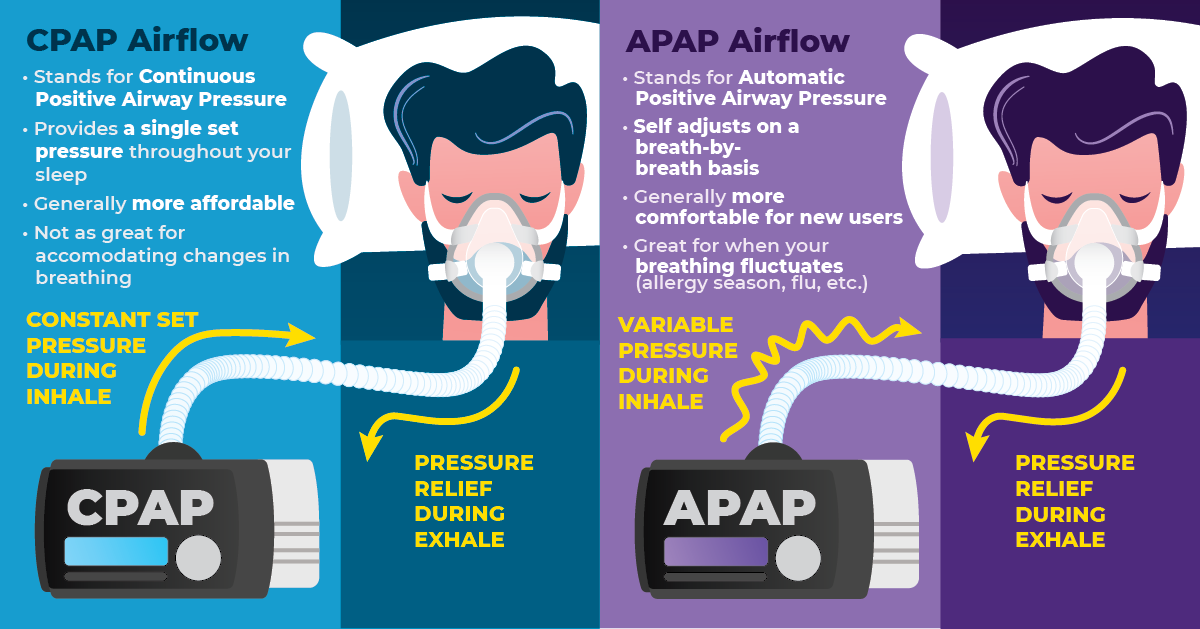
💡 Key Takeaways
- Core Difference: APAP machines automatically adjust air pressure in real time, while CPAP machines maintain a constant pressure setting throughout the night.
- Personalized Pressure Adjustments: APAP offers a more tailored treatment by adapting to your breathing patterns.
- Cost Considerations: APAP machines are generally more expensive, and your insurance might require you to try CPAP first before they cover an APAP machine.
- Suitability for Varied Sleep Patterns: APAP is ideal for those with fluctuating sleep apnea severity, seasonal allergies, or low tolerance for constant pressure.
- Versatility: Most APAP machines can also operate in CPAP mode, offering you flexibility in treatment options.
If you are worried that CPAP Therapy isn’t right for you, you may be wondering if there are alternative sleep apnea treatments. The answer is yes, but many people don’t realize that Continuous Positive Airway Pressure (CPAP) is not the only sleep apnea machine on the market today. In fact, there are several different types of PAP devices, including Auto Adjusting Positive Airway Pressure.
Of course, it can be hard to know which one of these is right for you, so we wanted to take this opportunity to explain the similarities and differences between APAP vs. CPAP. Sometimes referred to as an Auto CPAP, APAP is designed to automatically adjust the air pressure to your breathing patterns. Meanwhile, CPAP provides a constant stream of air set to one specific pressure reading.
We hope this article provides you with a solid understanding of these two types of sleep apnea devices as we compare and contrast APAP and CPAP machines. Our goal is for you to leave this article not only knowing more about each option but also whether APAP may be the sleep apnea treatment for you!
What Is the Difference Between APAP vs CPAP?
The key difference between APAP vs CPAP is the amount of air pressure being delivered. CPAP offers a continuous flow of air at a specific, pre-selected pressure setting. APAP machines automatically adjust air pressure based on your breathing patterns.
Of course, as Positive Airway Pressure devices, both machines use pressurized air to keep your airway open and regulate your breathing. This design is perfect for managing Obstructive Sleep Apnea but can also be useful for some people with Central Sleep Apnea or other sleep-breathing disorders. An Auto CPAP machine simply offers a more personalized form of respiratory support for those with sleep apnea, which tends to make breathing easier.
What Is an APAP Machine?
An APAP machine is designed to sense even tiny changes in your airway and breathing and then adjust the machine’s air pressure settings accordingly. The goal is to deliver the lowest amount of pressure necessary for that particular moment. Automatic Positive Airway Pressure maximizes comfort while still effectively treating sleep apnea. It is particularly effective for people who struggle to breathe with CPAP or for those who experience drastic fluctuations in their breathing patterns while they sleep.
Under normal circumstances, your breathing changes throughout the night depending on the stage of sleep or position you are sleeping in. These respiratory fluctuations can be aggravated by underlying health issues, and if they become too significant, they can actually make your sleep apnea worse or could cause your CPAP therapy to become less effective. An Auto CPAP machine ensures you are able to continue breathing normally, even if your air pressure requirements change from minute to minute.
What Is a CPAP Machine?
Like other Positive Airway Pressure devices, a CPAP machine directs a steady stream of pressurized air through the nose or mouth and into the airway. But unlike other PAP machines, this pressure level is determined by your doctor or some other sleep specialist. This pressure setting is constant and shouldn’t be changed without first consulting your healthcare provider.
Some people find it difficult to adjust to being on CPAP because they struggle to exhale against the flow of highly pressurized air. While some manufacturers do offer products to make this transition easier, and every machine has some sort of pressure relief feature that can help take the edge off, this is still an area where alternatives, such as APAP, are important.
Is APAP Better Than CPAP for Sleep Apnea Treatment?
Currently, CPAP therapy is the gold standard for most people with sleep apnea. This is largely due to its lower cost and simple design. And in many cases, a CPAP machine may be perfect if your breathing patterns do not fluctuate and you are able to adjust to sleeping with CPAP.
However, APAP therapy may be better for sleep apnea in some cases. APAP devices provide lower air pressure settings when exhaling, plus they detect subtle changes in your breathing patterns. Ultimately, they deliver a more targeted form of sleep apnea management. For example, if you have more apnea events while sleeping on your back compared to laying on your side or stomach, the APAP machine can adjust the air pressure accordingly.
Benefits of Auto CPAP Machines
- Automatic Adjustments to Pressure: The pressure that’s right for you today may not be the pressure that’s right for you tomorrow as your body changes. In some cases, lifestyle changes, in addition to any changes in medical conditions, may also impact the pressure you need to make your sleep apnea therapy a success.
- Convenience: It’s beneficial to have a device that automatically adjusts to the pressure you need, rather than having to spend time and money at the doctor’s office trying to pinpoint the perfect air pressure amount.
- Boosts Compliance Rates: Because they provide the perfect amount of air pressure during each breath, APAP machines are much easier to breathe with compared to CPAP. This makes it much easier to adjust to sleeping with an Auto CPAP and increases your likelihood of remaining therapy compliant.
- Can Become a CPAP Machine: Most APAP units can also be set to CPAP mode, allowing you to discover which titration therapy works best for you.
- Offers Personalized Sleep Apnea Treatment: Most people don’t have the same breathing patterns throughout the entire night. An APAP adjusts to fit your needs on a constant basis, even if your condition becomes more or less severe.
- Doesn’t Become Less Effective if Your Sick: If you have a cold or suffer from allergies, you can become congested, making breathing more difficult. Colds happen to everyone, and it’s nice to have a machine that can increase your air pressure automatically if you’re more congested than usual.
Downsides of Auto CPAP Machines
- Cost: While there are APAP machines that are cheaper than your average CPAP, Auto CPAP tends to be the pricier option. Feature for feature, an APAP device can run a couple hundred dollars more than a typical CPAP machine. For some customers, it’s a small price to pay for the comfort features, but for others, it may just be too pricey. Additionally, insurance companies may be more hesitant to cover APAP machines because they are technically more advanced than most CPAPs.
- Air Leak Sensitivity: Auto-adjusting CPAP machines can be particularly sensitive to air leaks, which can lead to inaccurate pressure changes throughout the night. APAP gives your mask seal little room for failure, so it’s important to find a CPAP mask that fits you just right when undergoing APAP therapy.
Who Is APAP Best For?
Whether it’s Automatic Positive Airway Pressure or Continuous Positive Airway Pressure, both are commonly used to treat sleep-disordered breathing conditions, particularly Obstructive Sleep Apnea. While CPAP is considered the first choice to treat sleep apnea, APAP therapy is primarily used in cases in which someone is struggling or is simply unable to breathe against the constant pressure of a CPAP machine.
Here are a few examples:
- Patients With Fluctuating Pressure Needs: APAP therapy is useful for people who experience changes in the severity of their Obstructive Sleep Apnea throughout the night. Because it is able to make adjustments as needed, using an Auto CPAP ensures you get just the right amount of pressure at all times.
- Your Apnea Events Increase During REM Sleep: Some people are more likely to experience Obstructive Sleep Apnea when they are in REM sleep due to the amount of relaxation the body undergoes during deep sleep. If you use a CPAP, your machine is set to provide you with sufficient air pressure to overcome this obstruction. But that air pressure stays with you all night long, even during the other sleep stages, even when it isn’t necessary.
- Positional Sleep Apnea: Some individuals experience airway obstructions only when sleeping in certain positions, such as on their back. In these cases, APAP therapy provides targeted support, delivering pressurized airflow when needed.
- Adherence Issues: Unfortunately, some people find it difficult to remain consistent with CPAP therapy due to the discomfort caused by air flowing at a constant pressure setting. APAP machines make it easy to breathe normally and offer a more comfortable experience, so they tend to be easier to adjust to.
- Titration Difficulties: Titration is the name of the process that is used to determine the appropriate pressure level for treating sleep apnea. In some cases, identifying the ideal pressure setting can be challenging. APAP therapy allows the machine to direct your pressure settings automatically as you sleep.
Related Article: Is Your CPAP Pressure Too High?
FAQs About CPAP vs APAP
Are APAP Machines More Expensive Than CPAP Machines?
Yes, an APAP machine is most likely going to be more expensive than your typical CPAP machine. Basic APAP machines start at $400, but prices can soar into the thousands. Meanwhile, traditional-style CPAP machines are around $300 at the low end but usually between $600 to $1,000.
Do Insurance Companies Cover APAP?
In some cases, insurance companies may be more likely to cover CPAP instead of APAP devices. While APAP machines are growing in popularity, many insurance companies still view them as a more expensive and technologically-advanced version of a CPAP machine. Some insurance policies may only agree to cover APAP after you have already tried CPAP.
Are APAP Machines Effective for Treating Sleep Apnea?
Auto CPAPs are highly effective for sleep apnea. Thanks to their automatic adjusting capabilities, these machines are able to change the exact amount of pressure that you need at any given moment. This cuts down on the number of times you receive air that is too highly pressurized, reducing your chances of experiencing many of the negative side effects of CPAP.
What Are the Similarities Between Auto CPAP and CPAP Machines?
Auto CPAP and CPAP machines both function very similarly and offer many of the same comfort features. APAP and CPAP both utilize Positive Airway Pressure, which delivers a continuous stream of pressurized air into the airway. This pressurized airflow prevents airway obstruction in people with Obstructive Sleep Apnea and encourages normal breathing patterns in people with mild to moderate Central Sleep Apnea.
What Are the Top-Rated APAP Machines?
Our favorite APAP machine is the AirSense 10 AutoSet CPAP Machine with HumidAir Heated Humidifier. It also happens to be one of our most popular APAP machines! It features a light, sleek design that is 23% lighter than previous versions and includes a built-in heated humidifier for maximum breathing comfort.
Related Article: Comparing the Best CPAP Machines
What Is AutoSet vs CPAP Mode?
AutoSet is the term that one popular APAP manufacturer, ResMed, uses to refer to their version of Auto CPAP. However, ResMed APAP machines also feature something called CPAP Mode, which effectively turns off the AutoSet feature and allows the machine to double as a CPAP machine.
Do APAP Machines Last Longer Than CPAP Machines?
Generally speaking, your APAP machine will need to be replaced about as often as a CPAP machine. Most traditional CPAP devices require replacement every three to five years. Similarly, our most popular Auto CPAP machine, the ResMed AirSense 11 AutoSet, last up to five years as well.
Do I Need a Special Mask for an APAP Machine?
You do not need a specific type of mask to use your APAP machine. While you can wear a CPAP mask during APAP therapy, keep in mind that not all CPAP masks are designed to meet your needs. For example, if you are someone who requires highly pressurized airflow, you may want to avoid a nasal pillow mask. And if you tend to feel claustrophobic, a full face mask may be very uncomfortable for you.
Related Article: Best CPAP Masks Compared
Can I Travel With My APAP Machine?
For those who like to travel with their sleep apnea devices, APAP machines are about as portable as your average CPAP machine. While APAP machines are often a bit bulky, they are pretty easy to travel with, as long as you have the right carrying equipment. And if you are someone who is regularly on the go, it may be worth considering a traveling CPAP or APAP.
Related Article: Best Travel CPAP Compared
What’s the Difference Between APAP vs BiPAP?
BiPAP machines offers two air pressure settings, one higher pressure for inhalation and a lower pressure setting during exhalation. On top of adjusting the air pressure based on whether you are inhaling or exhaling, APAP also constantly adjusts the level of pressure based on your breathing patterns.
Related Article: APAPvs BPAP: What’s the difference?
Is Auto Continuous Positive Airway Pressure the Same Thing as APAP?
Yes, the term Auto Continuous Positive Airway Pressure refers to the same type of device as an APAP. In fact, APAP tends to be called several different things, including:
- Auto Adjusting CPAP
- Auto Titrating CPAP
- Self Adjusting CPAP
- Auto PAP
- Automatic CPAP
- AutoSet
- SmartPAP
What Are the Types of Positive Airway Pressure Devices?
There are four main types of Positive Airway Pressure machines, which vary from most to least technologically involved. Your most common options for PAP therapy include the following:
- Continuous Positive Airway Pressure (CPAP)
- Bi-Level Positive Airway Pressure (BiPAP)
- Auto Adjusting Positive Airway Pressure (APAP)
- Adaptive Servo Ventilation (ASV).
Does APAP Treat Obstructive Sleep Apnea?
APAP is a great option for treating Obstructive Sleep Apnea. In some people, OSA gets more severe as you fall deeper asleep. Others experience worsening airway obstructions depending on the position they are lying in. In these cases, it is very helpful to have the option of having your air pressure increased during those periods but then decreased for those times when your OSA is less severe.
Final Thoughts
APAP machines have the same therapeutic goal as CPAP and BiPAP, but with a difference, they can automatically adjust air pressure to suit your changing needs as you sleep. This means you can begin therapy faster, make fewer trips to the doctor, and save on costs and time.
Some CPAP wearers choose an APAP machine because they feel the variable air pressures make their treatment more comfortable and easier to use. Remember, when choosing between CPAP vs APAP or any other sleep apnea treatment, the number one goal is to treat your sleep apnea successfully and maintain compliance throughout your therapy journey.
We hope this helped you make a decision to choose the right machine that best fits your personal sleep needs. Leave a comment below and join our sleep apnea community at CPAPTalk.com to get answers from experienced sleep apnea wearers and experts!




12 Responses
Is this covered by my insurance, most likely? I use a CPAP right now….;.;
ELAINE ELKO
IS THE LUMIN CPAP CLEANING MACHINE BETTER THAN THE “SO-CLEAN” BRAND??
COVERED BY INSURANCE OR CAN FLEX SPENDING BE USED??
Thanks for the great questions, Elaine!
This all depends on your preferred cleaning method. The Lumin CPAP cleaner is very convenient and operates differently than other cleaning products, using UV light to destroy 99% of bacteria, viruses, mold and fungi. Please call 1-800-356-5221 for assistance regarding payment options!
Michael
can an apap replace a bipap?
Hi Allen,
We advise all customers to use the machine type recommended by their doctor. That being said, it’s important to note the differences between an APAP or BiPAP and speak with your doctor about your personal sleep preferences.
BiPAP machines provide two distinct pressures. The higher pressure is needed for inhalation, while the lower pressure in need for exhalation. The lower pressure is intended to help you breathe out against the pressure of the machine.
Auto Adjusting CPAP machines, or APAPs, adjust to your ideal pressure on a breath by breath basis. They can accommodate pressure changes from weight gain or loss, alcohol before bed and changing sleeping positions during sleep.
Michael
Can you provide links to medical studies that say APAP is better than CPAP. Many years ago my doctor told me CPAP was better. I realize technologies change and sometimes medical opinions change – trying to get the most updated information.
Here’s a link to a journal article I found that comes to the same conclusion: https://www.ncbi.nlm.nih.gov/pmc/articles/PMC3351715/.
I have a DreamStation Auto Cpap. I have a problem with the variation in sound when the machine is in the auto mode–my breathing tries to sync with the sound variation of the machine, so I now have it set on cpap. I would like to have it on auto..Any suggestions ?
I have the same people with the dreamstation CPAP — I feel as though I have to match my breathing to the high and low pressure cycling but this leads to short and shallow breathing.
I’d be interested to hear if anyone thinks that auto pap would be better, and if so, how do you find these settings on the machine?
Hi Pattie, I am a fan of auto-titrating machines because the machine will give you the pressure that you need on a breath-by-breath basis. This way, you are not receiving too little, or too much pressure. Please speak with your doctor about your interest in using your machine in auto-mode.
If your machine has this feature and you would like to change the mode, we will be more than happy to assist you with the setting change. Please reach us at: 800-356-5221.
Enjoy your day!
Every APAP I have used is basically an adjusting Bi-PaP. You set the min and Max pressure. Say 6 to 18. As you breath as long as everything is going good the pressure will stay low, one it determines a problem, even so slight you don’t notice, it increases pressure until the breathing is within normal or max pressure is hit.
I had a Bi-PaP at 6 and 18. ( Wonder where those numbers from above were from?). With data from also my Max pressure used was usually under 9, occasionally if congested to 12-13.
When I had Bi-PaP the high pressure was obviously much higher than I needed and I almost always woke up with a puffy feeling in face and eyes.
With lower pressure I had less leakage, blowby ( nasal pillows) and issue with mouth leakage. Add to this I was able to just remove the humidifier. Didn’t need it with APAP. ( Because of APAP or just used to it, I don’t know). Been using a system one from Phillips for about 7 years.
But research paper, bring info to your doctor (he may not know much about them, mine didn’t) and see if he thinks they are right for you. Best thing is, most if not all APAP will let you disable the auto and run as a standard Bi-PaP and if you have min and Max pressures set to Sam, as a CPAP.
Hope this helps. I am not a pap expert but 7 years using and stayed at a holiday inn Express.
I use a Dream Station Auto SV.
As you are aware, there are horrendous, widespread forest fires blanketing the NorthWest where i live right now. I keep all the house windows closed but it is impossible to keep the smoky odor out of my house. Consequently, the SV intake collects what smoky odor there is under my bed and “supercharges” it into my lungs. I wake often and have a sore throat from the smoke. Additionally, I meticulously clean what I can of the machine but there’s no way to clean the inside of the machine where smoke particles seem to be lingering… so two questions:
1 Is it alright to run the machine for several hours without any accessories attached to try to purge the smoky odor from inside, and
2 is there any kind of remote ‘super’ filter that can be attached outside of the machine to trap really offensive odors (whenever a skunk goes off outside the machine gathers his stink and it’s like he’s sitting on my chest!)?
Jim